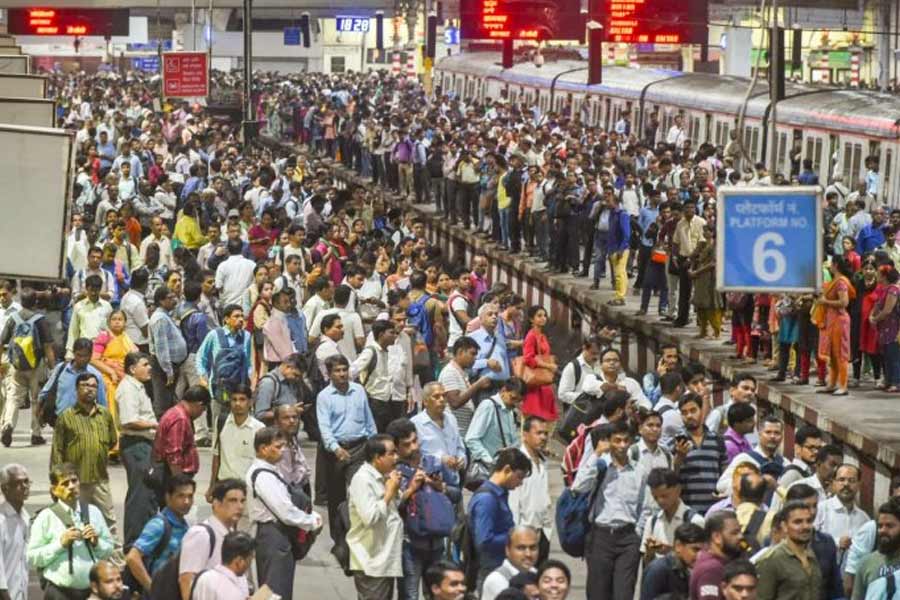Mithilesh Chaudhary, 21, coughs weakly as he struggles to his feet after spending the night outside the state-run All India Institute of Medical Sciences (AIIMS) in New Delhi.
"We have been sleeping on the footpath for two nights,” said his grandfather Bhim Lal, as the two waited in a line of about 100 people outside the hospital's main gate, seeking an appointment.
"He suffers from chest congestion, and no one has been able to tell us what exactly is the issue. We have been to many hospitals around our district and finally, a doctor at a private hospital asked us to visit the AIIMS in Delhi.”
Chaudhary, who lives 1,200 km away in Bihar state, doesn't have an appointment and was not given the name of a doctor. His only recourse is to stand in the queue until he can get one of the few slots that open up every morning for those waiting outside.
His plight and that of others who queue every day starting at dawn highlights the shortage of specialist doctors and health workers in India's countryside, where more than two-thirds of its 1.43 billion people live.
Prime Minister Narendra Modi's government has built more than a dozen similar medical institutes for specialised treatment since he took office in 2014. The government has plans to build at least one major hospital in each of India's 761 districts.
The problem is a lack of doctors, a shortage that is reaching crucial levels as India becomes the world's most populous nation.
India's doctor-to-patient ratio hit a record high of 1.2 doctors per 1,000 patients in 1991, according to the World Health Organisation (WHO), but as its population surged, the ratio dropped to about 0.7 in 2020.
The WHO recommended level is 1 and China, with a comparable population to India, is at 2.4.
Health Minister Mansukh Mandaviya told parliament in March that India in fact had a ratio of 1 doctor per 834 patients, well above the WHO level, but the number included doctors practising traditional forms of medicine such as Ayurveda, Homoeopathy, and Naturopathy.
The WHO and doctors groups such as the Indian Medical Association do not include traditional medicine practitioners in their calculations.
Inaugurating the first specialised medical institute in northeast India last month, Modi said his government had sought to increase the number of doctors by setting up more medical colleges.
"This deficiency was a major barrier to quality health services in India," he said. "Therefore, our government has worked on a large scale to increase medical infrastructure and medical professionals in the last nine years."
The number of public hospitals, excluding specialised institutes, has risen some 9% in Modi’s time at the top, government data shows.
Rural gaps
The government has nearly doubled the number of undergraduate medical seats in private and public colleges to 101,043 as of March from 51,348 before 2014, according to health ministry data.
More than 1.76 million students appeared in tests for those seats last year.
Still, there were more than 3,000 doctor vacancies at 31 large federal government hospitals, including more than a dozen specialised institutes, according to a parliament reply by the health ministry in February. Vacancies of nurses and support staff were more than 21,000.
At the Jawahar Lal Nehru Medical College, an 800-bed hospital in the largely rural Bhagalpur district in Bihar, a senior doctor said the medicine department - the first point of contact for patients - for example, had only half the number of required doctors in the past five years.
"We have to provide proper patient care no matter what... but with an inadequate staff, the workload increases and becomes very difficult to manage, especially since we have to teach undergraduates too," said the doctor, declining to be named.
Outside the big cities, the lack of specialised care is especially acute. The government says there was a near 80% shortage of surgeons, physicians, gynaecologists and paediatricians at community health centres in rural India as of March 2022.
There were 4,485 specialists in position at these small hospitals against a requirement of 21,920, according to the government data.
Specialist doctors tend to go overseas or join the private sector in metropolitan and other large cities, said Dr K. Srinath Reddy, at the Public Health Foundation of India non-profit.
"They have been trained in tertiary-care environments and may not be suitably skilled or emotionally aligned to rural conditions in low-resource settings," Reddy said.
Dr Vandana Prasad, a technical adviser at the non-profit Public Health Resource Network, said people in rural areas tended to go to the cities for treatment.
"There's a certain trust in the hospitals that exist in larger metropolitan cities and there's a kind of an environment which suggests to people that they should seek more and more expensive or more specialised care," she said. That was the main reason for the large number of cases and the crowds outside the hospital, said Dr Syed Ahmed, a resident doctor at the AIIMS in Delhi. "A lot of the cases can be dealt with at primary care level," he said.
By Shivam Patel











